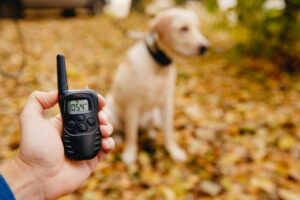Dogs are lovely creatures that add vibrancy and joy to households. Notwithstanding, these creatures may sometimes exhibit behaviors we find infuriating.
Over the years, many devices have been produced to help correct dog bad behaviors. One of them which usually sparks controversies among dog owners is the Shock collars. While some dog owners believe that a shock collar is the best device for correcting their dog’s bad behavior, others believe that shock collars are the least humane approach to correcting a dog’s behavior.
But, what’s the truth of this matter? Are shock collars bad for dogs? The short answer to this question is YES! While shock collars may seem a swift solution to train your canine companion, the disadvantages of this method outweigh its advantages.
In this article, we have revealed some lesser-known negative effects of shock collars on dogs. You will also get to know some better approach that offers long-term results in correcting your dog’s bad behaviors.
Without further ado, let’s dive in!
What Are Shock Collars?

Before delving into the effects of shock collars on dogs, let’s first understand what shock collars are. Shock collars, also known as electronic collars or e-collars, are training devices designed to modify a dog’s behavior through the delivery of electric stimulation.
These collars consist of a strap that fits around the dog’s neck and an electronic module equipped with electrodes that can administer mild electric shocks to the dog when triggered. The intensity of the shock can be adjusted according to the dog’s size, breed, and temperament.
Although this device was originally developed to train hunting dogs, it has been repurposed for correcting dog behaviors such as excess barking, digging, and pulling on leashes, and also to confine dogs within certain boundaries.
Why You Should Not Use Shock Collars on Dogs
There are a lot of reasons why you should avoid using shock collars on dogs. Shock collars operate on the principle of inflicting discomfort to discourage certain behaviors in dogs. The dog will then associate the unpleasant sensation with the undesired behavior, thus ceasing to repeat it.
This might seem like a smart technique, but it is not. Anything that causes your dog discomfort or pain is inhumane and should be avoided at all costs.
Below are some of the Hidden Negative Effects of Shock Collars on Dogs:
Physical Effects of Shock Collars on Dogs

Shock Collars Hurt Dogs
The electrical shock from this device may not be potent enough to cause skin burns or injuries. Nevertheless, it hurts dogs. The device may also malfunction, leading to the production of excessive shock which may be detrimental to your dog’s health.
It Causes Physical Harm or Injury
While many pet companies claim that shock collars are 100% safe for dogs, the reality is quite different. The shock from this device may be mild and unable to cause physical injury, however, two metallic electrodes are usually attached to this device. These electrodes will always make contact with your dog’s skin and prolonged contact with the skin may lead to physical injury which can become infected if left untreated.
It Affects Dog Overall Well-Being and Quality of Life
Shock collar reduces the overall well-being of dogs. Your happy dog might suddenly become sad and aggressive towards you.
It might even be worse if you are wearing the shock collar to prevent barking. Imagine getting electrocuted anytime you open your mouth to speak. That is inhumane, right? YEAH! That’s how it feels when you also wear a shock collar around the dog’s neck to prevent them from barking.
Psychological Effects of Shock Collars

Shock collars don’t only have physical effects on dogs, they can also aggravate psychological effects such as:
Fear And Anxiety
Shock collars can cause fear and anxiety in dogs. When a dog is subjected to the sudden, unpredictable jolts of pain or discomfort delivered by these collars, they can associate the pain with various stimuli, including their owner or their environment.
This association can lead to heightened anxiety and fear, as the dog will be unsure when the next painful experience will occur.
It Decreases the Trust and Bond Between the Dog and the Owner
Dogs are loyal creatures and they believe that as their owner, you are supposed to help them in times of pain and discomfort.
Your dog may associate the electric shock with your presence. If this occurs, the bond between you and your dog will be hampered and he will no longer feel safe around you.
It Causes Aggression and Behavioral Issues
Instead of controlling the behaviors, shock collars might even aggravate them. The pain causes anxiety which may further exacerbate aggression in your dog.
Current Laws and Regulations Regarding Shock Collar Use
The use of shock collars on dogs is a controversial issue. Some states or jurisdictions in the United States, Finland, and some other countries have placed a ban on the use of shock collars.
In Australia, regions such as the ACT, NSW, and South Australia prohibit the placement of an electric dog collar on a dog’s neck and anyone caught doing this would be punished accordingly.
However, in some regions such as West Australia & Victoria, the usage of electric dog collars is permitted for dog training, anti-barking, and confinement only. Using the collar on dogs for an unauthorized reason may warrant an arrest or punishment.
Positive & Healthy Alternatives to Shock Collars

Facing the harsh consequences of shock collars, it becomes clear that we need more humane approaches to dog training.
Here are a few reliable alternatives to using shock collars:
Positive Reinforcement Training
Instead of making your dog associate bad behavior with bad sensations, simply make it associate good behaviors with positive outcomes.
Positive reinforcement is one of the best training methods used by dog trainers. It involves praising your dog or giving it treats anytime he exhibits desirable behaviors.
Let’s say your dog barks too much and you aim to stop it from barking excessively. Below is what you should do:
- Establish a “Quiet” Command: Choose a specific command like “quiet” or “enough” that you’ll use consistently to signal your dog to stop barking.
- Reward your dog anytime it obeys: Whenever your dog stops barking on command, immediately reward them with a high-value treat, praise, and affection. Make sure the reward is something your dog finds particularly enticing. Your reward should be given the moment your dog stops barking, so they understand the connection between the command and the reward.
- Consistency: Be consistent in your use of the “quiet” command and rewards. Everyone in the household should use the same command and provide rewards when the dog complies.
This method works like magic! It focuses on rewarding good behavior rather than punishing bad behavior. It creates a positive relationship with the dog and establishes trust.
Desensitization & Counter Coding
According to Dr. Ballantyne, a professional dog behaviorist. “When trying to correct a dog’s bad behavior, it is important to know the underlying issue first”.
Take, for example, a dog’s excessive barking. Numerous reasons can cause a dog to bark excessively. It might be a result of anxiety, boredom, or even health issues.
The best approach to solving this issue is to identify the underlying issue and counter it with a solution. If it’s a health issue, kindly take your dog for treatment.
If you notice that it is caused by anxiety, the best solution is to create a more comfortable environment for your dog and get rid of any stressor that may exacerbate anxiety in your dog.
It may also be because they are feeling unsafe, making them bark at people walking on the street through the window, in this case, consider covering the windows. These little steps are very effective compared to using shock collars.
Clicker Training
A clicker, a small device that makes a distinct sound, can be used to signal the exact moment a dog performs a desired behavior, followed by a reward. This technique makes training more precise and enjoyable.
Consult with a Professional Dog Trainer
Instead of using shock collars, consider enrolling your dog in obedience classes, this is an excellent way to teach them appropriate behavior using positive methods.
You may also consider consulting a professional dog trainer or behaviorist who can provide tailored advice and training plans for your dog.
Stories From Dog Owners and Professionals

For more transparency and information, we had to make inquiries from dog owners and professional dog trainers about their experience in using shock collars to correct dog behavior.
Below is some feedback gotten from them:
From a Dog Owner (The case of Brownie): Brownie, a six-year-old Labrador, initially had severe anxiety and fear-related behavior issues. Her original owner resorted to using shock collars to address excessive barking, assuming that it would stop the behavior. However, shock collars had unintended consequences for Brownie.
Instead of associating the shock with her barking, she associated it with the presence of doors. This led to a fear response towards doorways and eventually generalized anxiety about various unfamiliar things.
This real-life story illustrates how shock collars may not work as intended and can result in long-term collateral damage.
From a Professional Dog Trainer (The Case of Duke): Early in my career, I trained a lively German Shepherd named Duke using shock collars, hoping to correct his behavior. However, it became clear that this method had its flaws.
Duke would yelp in fear, and his spirit seemed to wither away. He followed commands, not because he learned, but out of sheer terror.
I decided to change my approach and ditched the shock collar for positive reinforcement. The change was remarkable. Duke’s unwanted behaviors disappeared, and he did so eagerly and happily. He regained his confidence, and our bond grew stronger.
Shock collars might bring momentary obedience, but they shatter trust and cause unnecessary suffering. Positive reinforcement not only works better; it ensures a happier, healthier, and trust-filled relationship with our furry friends.
Conclusion
In a world where our pets increasingly become part of our families, it’s essential to treat them with the same respect and kind-heartedness we would give to any family member.
The short answer to the question “Are shock collars bad for dogs?” is YES! Shock collars hurt dogs, they can inflict injury on dogs, cause aggression, and also affect their life psychologically.
Positive and Healthy Alternatives such as positive reinforcement, clicker training, or seeking help from professional trainers show that discipline doesn’t have to be synonymous with punishment.
By adopting these methods, you’ll not only see an improvement in your canine friend’s behavior but also strengthen the bond you share.
“The bond between you and your pet thrives on love, not fear. Choose training methods that cultivate this bond.”







Leave a comment